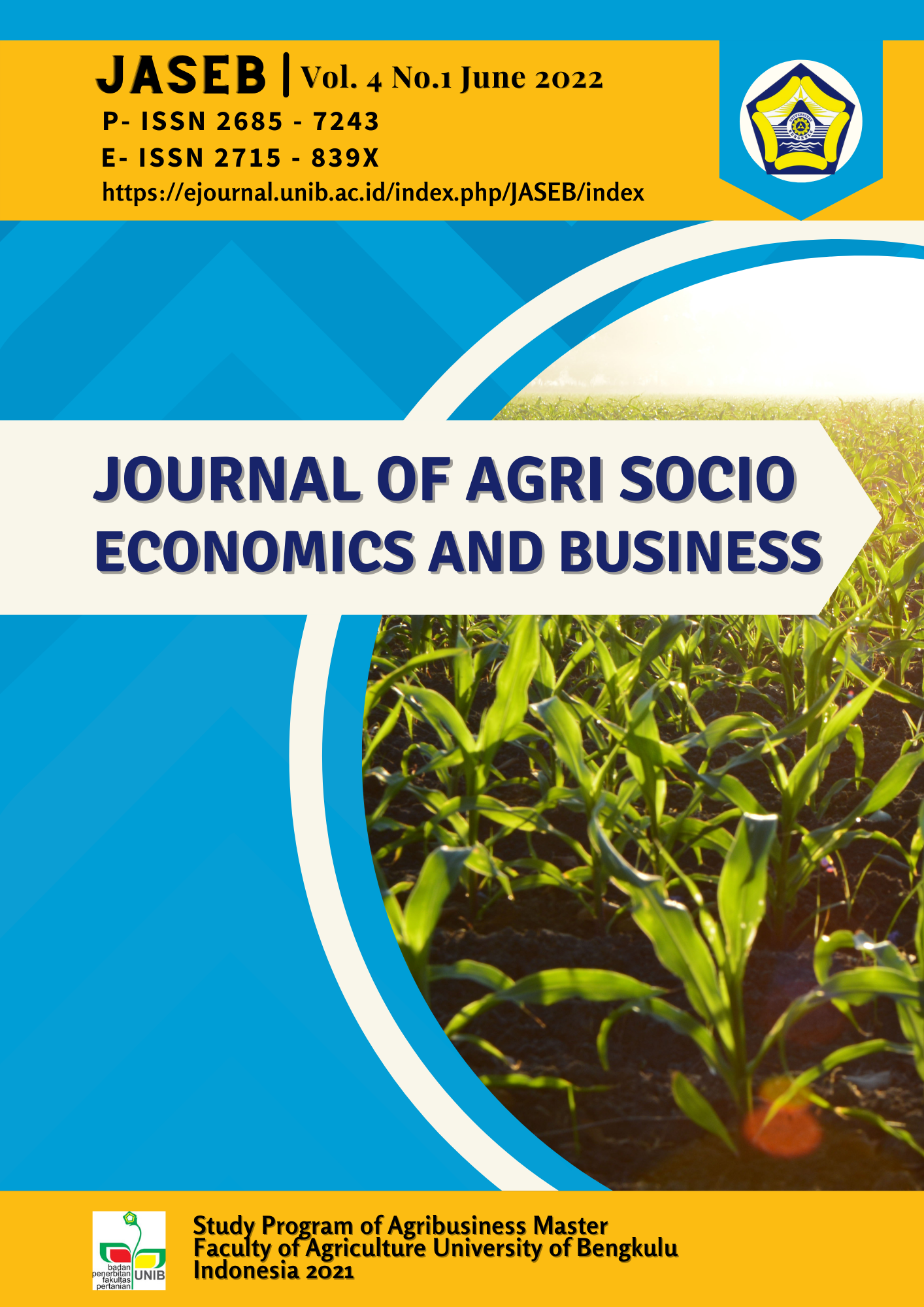Main Article Content
Abstract
Aquaculture is one of the most profitable businesses for the community economically. South Bengkulu Regency has great potential in meeting the demand for tilapia in the
market. However, in 2018 there was a reduction in water discharge, damage to irrigation channels that began to rot or age. Based on the existing problems, the motivation of farmers who cultivate tilapia business is reduced. The purpose of the study: 1. to analyze the motivation of farmers to maintain tilapia farming, 2. What factors influence the motivation of farmers to maintain tilapia farming in South Bengkulu Regency. This study uses two types of data analysis, namely the first Likert analysis and SEM analysis. The results of this study indicate that: 1. The motivation of Tilapia fish farmers can be said to be very high motivation in maintaining their farming. 2. There are two influencing factors, namely factors that directly affect the availability of production facilities (X1), Government support (X2), Environmental Inputs (X3), Family Head Resource Inputs (X4), Management (X5 ).) and Output (X6), while the factors that do not directly affect the Availability of Production Means (X1) affect Government Support (X2) in shaping Farmer's Motivation (Y) and the Input of Family Head Resources (X4) affects Output ( X6) in shaping the motivation of farmers (Y).
Keywords
Article Details
An author who publishes in the Journal of Agri Socio Economics and Business agrees to the following terms:
Author retains the copyright and grants the journal the right of first publication of the work simultaneously licensed under the Creative Commons Attribution-ShareAlike 4.0 License that allows others to share the work with an acknowledgement of the work's authorship and initial publication in this journal
Submission of a manuscript implies that the submitted work has not been published before (except as part of a thesis or report, or abstract); that it is not under consideration for publication elsewhere; that its publication has been approved by all co-authors. If and when the manuscript is accepted for publication, the author(s) still hold the copyright and retain publishing rights without restrictions. For the new invention, authors are suggested to manage its patent before published. The license type is CC-BY-SA 4.0.
Journal Agri Socio-Economics and Business is licensed under a Creative Commons Attribution-ShareAlike 4.0 International License.
References
- Fahma, Insanai N. Kustanti, A and Hilmanto, R. 2015. Motivation of Farmers in Managing Community Forests in Sukuharjo 1 Village, Sukoharjo Subdistrict, Pringsewu Regency. Slyva Lestari Journal. 3(3) : 51-62.
- Handoko, T. Hani. 1995. Personnel Management and Human Resources. Second
- Edition, BPFE UGM, Yogyakarta.
- Irwandi. 2015. Analysis of Income and Business Efficiency of Tilapia (Oreochromis Niloticus) in Mekar Mulya Village, Penarik District, MukoMuko Regency. Journal of Agripep. 15(2) : 237-235.
- Ningsih, FS 2017. Analysis of Policies Affecting Financial Performance of the Fish
- Processing Industry and Economic Performance of Fishing and Food Security of Fishermen in Bengkulu City. Essay. Faculty of Agriculture, Bengkulu
- University. Bengkulu (unpublished).
- Octaviani, E. 2016. Factors Influencing the Acceptance and Use of Exelsa Learning
- Management System at Sanata Dharma University. Thesis. Faculty of
- Economics, Sanata Dharma University, Yogyakarta.
- Purwantini, AH, and Friztina, A. 2018. Analysis of Social Commerce Utilization for MSMEs: Antecedents and Consequences. Compartment: Scientific Journal of Accounting. 16(1):47-63.
- Prayitno, H. 1987. Rural Economic Development. BPFE. Yogyakarta
- Rindang Baiq, A., Wahid Abdul, H., Ayu Turniningtyas, R. 2017. The Motivation of Farmers to Maintain Agricultural Land in the Suburbs of Malang City (Case Study of Karangploso Urban Area, Malang Regency). Journal of Regional and Rural Development Planning. 1(3): 258-269
- Samsudin, Sadili. 2010. Human Resource Management. Bandung: Faithful Library. Sugiyono. 2013. Educational Research Methods QuantitativeApproaches, Qualitative,
- and R&D. Bandung: Alphabeta.
- Susanti, Rini. 2012. Characteristics of Coffee Farmers in Bukit Kemuning Village, Bukit
- Kemuning District, North Lampung Regency in 2011. Lampung, LampungUniversity
- Wiyono. 2011. Designing business research with SPSS and SmartPLS 2.0.Yogyakarta: YKPN STIM YKPN Publishing and Printing Unit.
- Wullur, Farra, Longdong Florence and Wasak Martha. 2013. The Existence of Tilapia
- (Oreochromisniloticus) Farmers in Warukapas Village, Minahasa Regency, North Sulawesi Province. Journal of Acculturation.3(6):265-267.
References
Fahma, Insanai N. Kustanti, A and Hilmanto, R. 2015. Motivation of Farmers in Managing Community Forests in Sukuharjo 1 Village, Sukoharjo Subdistrict, Pringsewu Regency. Slyva Lestari Journal. 3(3) : 51-62.
Handoko, T. Hani. 1995. Personnel Management and Human Resources. Second
Edition, BPFE UGM, Yogyakarta.
Irwandi. 2015. Analysis of Income and Business Efficiency of Tilapia (Oreochromis Niloticus) in Mekar Mulya Village, Penarik District, MukoMuko Regency. Journal of Agripep. 15(2) : 237-235.
Ningsih, FS 2017. Analysis of Policies Affecting Financial Performance of the Fish
Processing Industry and Economic Performance of Fishing and Food Security of Fishermen in Bengkulu City. Essay. Faculty of Agriculture, Bengkulu
University. Bengkulu (unpublished).
Octaviani, E. 2016. Factors Influencing the Acceptance and Use of Exelsa Learning
Management System at Sanata Dharma University. Thesis. Faculty of
Economics, Sanata Dharma University, Yogyakarta.
Purwantini, AH, and Friztina, A. 2018. Analysis of Social Commerce Utilization for MSMEs: Antecedents and Consequences. Compartment: Scientific Journal of Accounting. 16(1):47-63.
Prayitno, H. 1987. Rural Economic Development. BPFE. Yogyakarta
Rindang Baiq, A., Wahid Abdul, H., Ayu Turniningtyas, R. 2017. The Motivation of Farmers to Maintain Agricultural Land in the Suburbs of Malang City (Case Study of Karangploso Urban Area, Malang Regency). Journal of Regional and Rural Development Planning. 1(3): 258-269
Samsudin, Sadili. 2010. Human Resource Management. Bandung: Faithful Library. Sugiyono. 2013. Educational Research Methods QuantitativeApproaches, Qualitative,
and R&D. Bandung: Alphabeta.
Susanti, Rini. 2012. Characteristics of Coffee Farmers in Bukit Kemuning Village, Bukit
Kemuning District, North Lampung Regency in 2011. Lampung, LampungUniversity
Wiyono. 2011. Designing business research with SPSS and SmartPLS 2.0.Yogyakarta: YKPN STIM YKPN Publishing and Printing Unit.
Wullur, Farra, Longdong Florence and Wasak Martha. 2013. The Existence of Tilapia
(Oreochromisniloticus) Farmers in Warukapas Village, Minahasa Regency, North Sulawesi Province. Journal of Acculturation.3(6):265-267.
